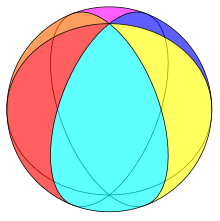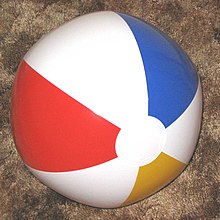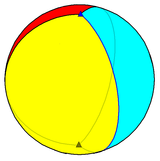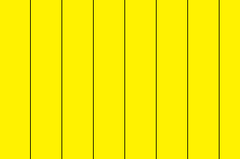Hosohedron
| Set of regularn-gonal hosohedra | |
|---|---|
 Exampleregularhexagonal hosohedron on a sphere | |
| Type | regularpolyhedronorspherical tiling |
| Faces | ndigons |
| Edges | n |
| Vertices | 2 |
| Euler char. | 2 |
| Vertex configuration | 2n |
| Wythoff symbol | n| 2 2 |
| Schläfli symbol | {2,n} |
| Coxeter diagram | |
| Symmetry group | Dnh [2,n] (*22n) order4n |
| Rotation group | Dn [2,n]+ (22n) order2n |
| Dual polyhedron | regularn-gonaldihedron |

Inspherical geometry,ann-gonalhosohedronis atessellationofluneson aspherical surface,such that each lune shares the same twopolar oppositevertices.
Aregularn-gonal hosohedron hasSchläfli symbol{2,n},with eachspherical lunehavinginternal angle2π/nradians(360/ndegrees).[1][2]
Hosohedra as regular polyhedra
[edit]For a regular polyhedron whose Schläfli symbol is {m,n}, the number of polygonal faces is:
ThePlatonic solidsknown to antiquity are the only integer solutions form≥ 3 andn≥ 3. The restrictionm≥ 3 enforces that the polygonal faces must have at least three sides.
When considering polyhedra as aspherical tiling,this restriction may be relaxed, sincedigons(2-gons) can be represented asspherical lunes,having non-zeroarea.
Allowingm= 2 makes
and admits a new infinite class of regular polyhedra, which are the hosohedra. On a spherical surface, the polyhedron {2,n} is represented asnabutting lunes, with interior angles of2π/n.All these spherical lunes share two common vertices.
| Space | Spherical | Euclidean | |||||
|---|---|---|---|---|---|---|---|
| Tiling name |
Henagonal hosohedron |
Digonal hosohedron |
Trigonal hosohedron |
Square hosohedron |
Pentagonal hosohedron |
... | Apeirogonal hosohedron |
| Tiling image |

|

|

|

|

|
... | |
| Schläfli symbol |
{2,1} | {2,2} | {2,3} | {2,4} | {2,5} | ... | {2,∞} |
| Coxeter diagram |
... | ||||||
| Faces and edges |
1 | 2 | 3 | 4 | 5 | ... | ∞ |
| Vertices | 2 | 2 | 2 | 2 | 2 | ... | 2 |
| Vertex config. |
2 | 2.2 | 23 | 24 | 25 | ... | 2∞ |
Kaleidoscopic symmetry
[edit]Thedigonalspherical lunefaces of a-hosohedron,,represent the fundamental domains ofdihedral symmetry in three dimensions:the cyclic symmetry,,,order.The reflection domains can be shown by alternately colored lunes as mirror images.
Bisecting each lune into two spherical triangles creates an-gonalbipyramid,which represents thedihedral symmetry,order.
| Symmetry (order) | Schönflies notation | |||||||
|---|---|---|---|---|---|---|---|---|
| Orbifold notation | ||||||||
| Coxeter diagram | ||||||||
| -gonal hosohedron | Schläfli symbol | |||||||
| Alternately colored fundamental domains | 
|

|

|

|

|

| ||
Relationship with the Steinmetz solid
[edit]The tetragonal hosohedron is topologically equivalent to thebicylinder Steinmetz solid,the intersection of two cylinders at right-angles.[3]
Derivative polyhedra
[edit]Thedualof the n-gonal hosohedron {2,n} is then-gonaldihedron,{n,2}. The polyhedron {2,2} is self-dual, and is both a hosohedron and a dihedron.
A hosohedron may be modified in the same manner as the other polyhedra to produce atruncatedvariation. The truncatedn-gonal hosohedron is the n-gonalprism.
Apeirogonal hosohedron
[edit]In the limit, the hosohedron becomes anapeirogonal hosohedronas a 2-dimensional tessellation:
Hosotopes
[edit]Multidimensionalanalogues in general are calledhosotopes.A regular hosotope withSchläfli symbol{2,p,...,q} has two vertices, each with avertex figure{p,...,q}.
Thetwo-dimensional hosotope,{2}, is adigon.
Etymology
[edit]The term “hosohedron” appears to derive from the Greek ὅσος (hosos) “as many”, the idea being that a hosohedron can have “as manyfaces as desired”.[4]It was introduced by Vito Caravelli in the eighteenth century.[5]
See also
[edit]References
[edit]- ^Coxeter,Regular polytopes,p. 12
- ^Abstract Regular polytopes, p. 161
- ^Weisstein, Eric W."Steinmetz Solid".MathWorld.
- ^Steven Schwartzman (1 January 1994).The Words of Mathematics: An Etymological Dictionary of Mathematical Terms Used in English.MAA. pp.108–109.ISBN978-0-88385-511-9.
- ^Coxeter, H.S.M. (1974).Regular Complex Polytopes.London: Cambridge University Press. p. 20.ISBN0-521-20125-X.
The hosohedron {2,p} (in a slightly distorted form) was named by Vito Caravelli (1724–1800)…
- McMullen, Peter;Schulte, Egon (December 2002),Abstract Regular Polytopes(1st ed.),Cambridge University Press,ISBN0-521-81496-0
- Coxeter, H.S.M,Regular Polytopes(third edition), Dover Publications Inc.,ISBN0-486-61480-8








![{\displaystyle [n]}](https://wikimedia.org/api/rest_v1/media/math/render/svg/a26847bfc29bbeb4d6ef62ac3fd076378c0fd1db)
















![{\displaystyle [\,\,]}](https://wikimedia.org/api/rest_v1/media/math/render/svg/2fa4c06a6c3b5a7bee90e2c44f7530e3f2a46bf8)
![{\displaystyle [2]}](https://wikimedia.org/api/rest_v1/media/math/render/svg/aa32363c093f4cfd50ecba68068bcfd396ea8bff)
![{\displaystyle [3]}](https://wikimedia.org/api/rest_v1/media/math/render/svg/f671027d56f9c24d65c03a4a26eb0d3b933f4f15)
![{\displaystyle [4]}](https://wikimedia.org/api/rest_v1/media/math/render/svg/3d865272ff436d713d5069ae3066bbe07a000a99)
![{\displaystyle [5]}](https://wikimedia.org/api/rest_v1/media/math/render/svg/958ef87021d704de46ad116821bc677e07d9a5fe)
![{\displaystyle [6]}](https://wikimedia.org/api/rest_v1/media/math/render/svg/162951515fcb56919dffe17b119f4a0aa7e9dae6)








